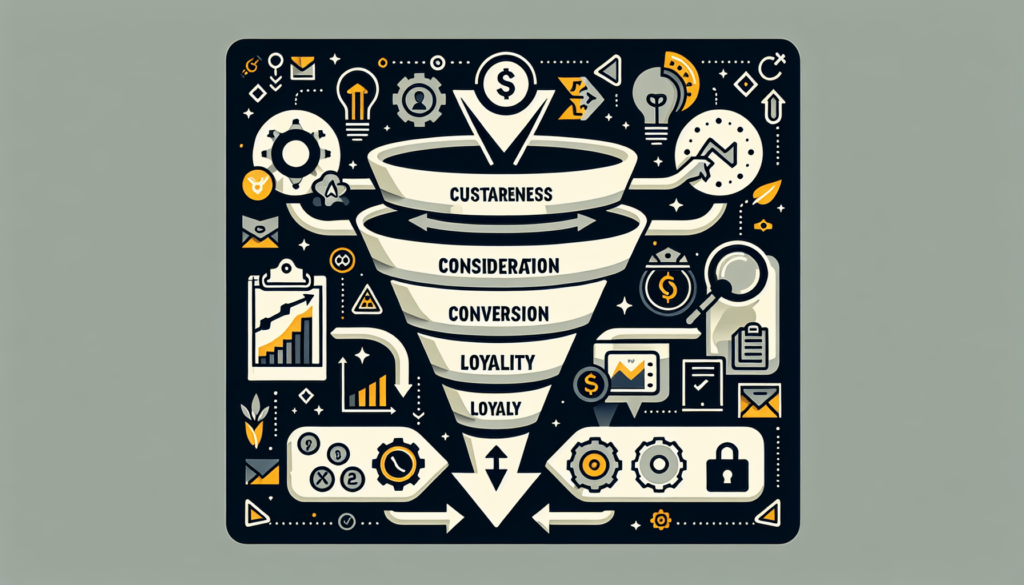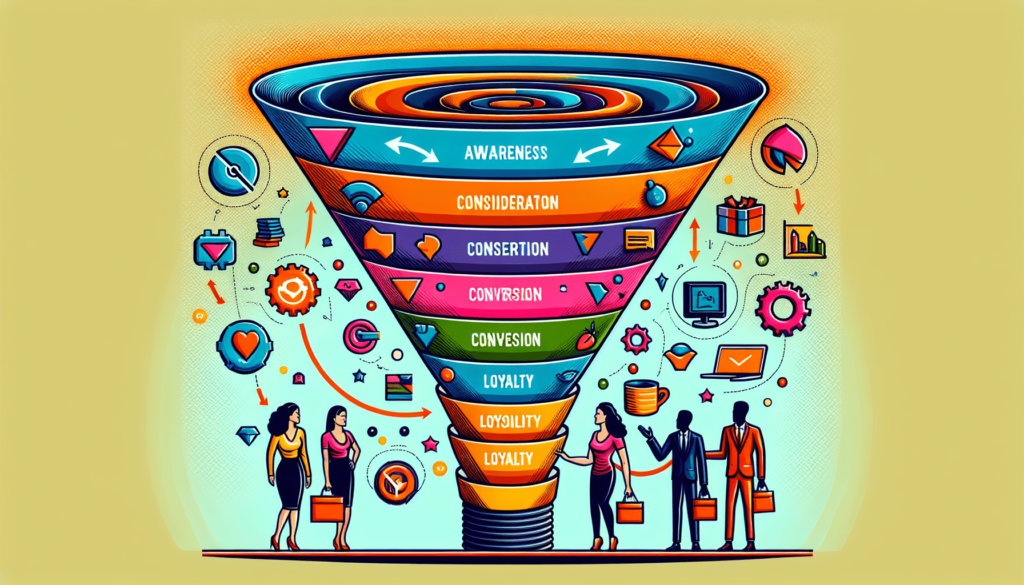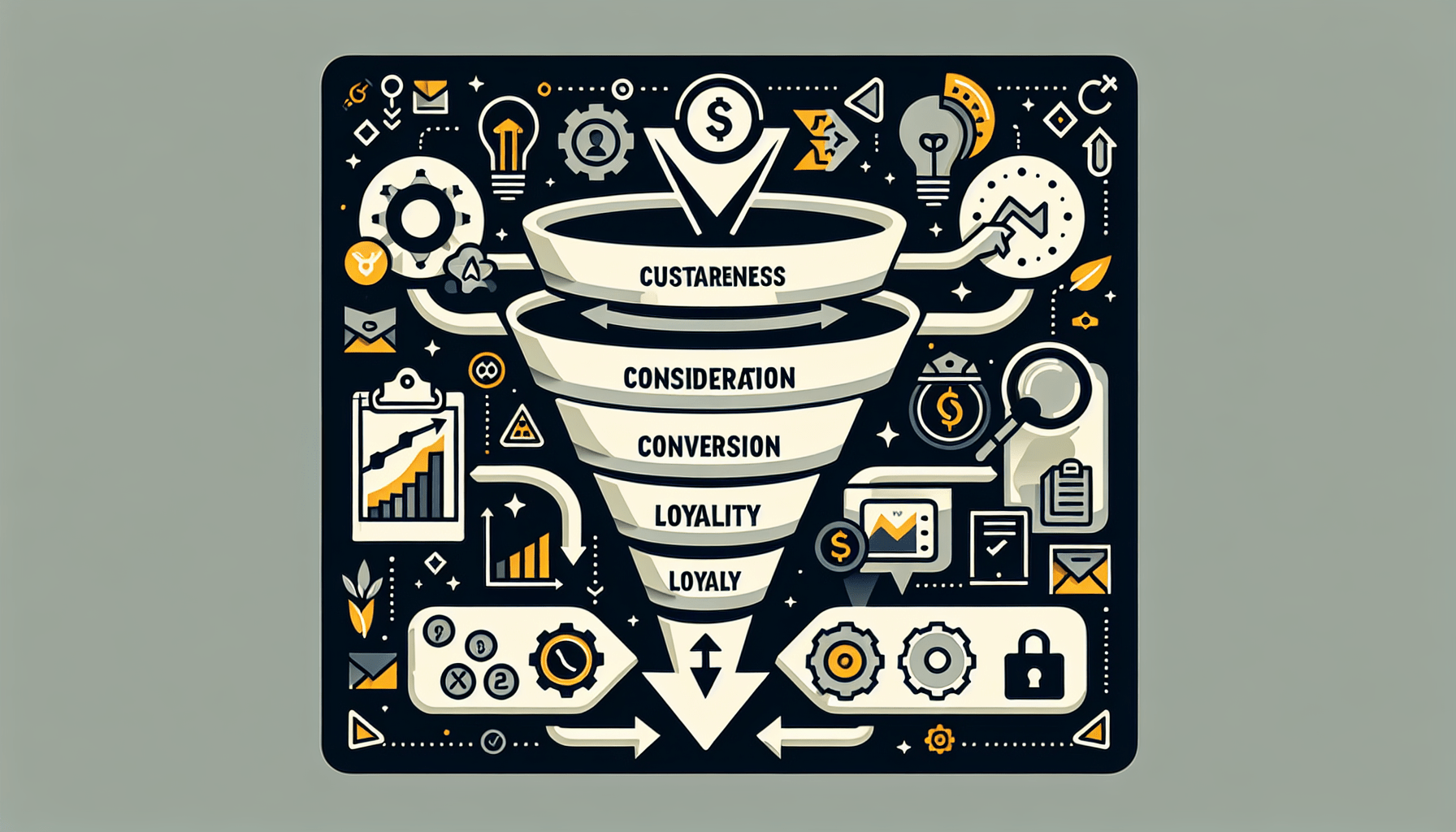Are you looking to enhance your marketing strategies and increase your customer engagement? Look no further! In this article, we will explore the concept of the customer journey in funnel marketing. By understanding the path that customers take from initial awareness to purchase, you can optimize your marketing efforts for maximum impact. Join us as we unravel the mysteries of the customer journey and discover how to effectively guide your audience through the different stages of the marketing funnel. Get ready to take your marketing game to the next level!

What is Funnel Marketing?
Funnel marketing is a strategic approach that guides potential customers through a series of stages within their journey, ultimately leading them to make a purchase or conversion. The term “funnel” refers to the shape of the customer journey, which starts with a wide pool of prospects and narrows down as they move closer to making a decision. Funnel marketing involves the systematic use of various marketing tactics and tools to attract, engage, and convert customers.
Definition of Funnel Marketing
Funnel marketing, also known as the marketing funnel or sales funnel, is a concept that visualizes the process of capturing and nurturing leads through different stages of the customer journey. It involves employing targeted strategies and tactics to move potential customers from the awareness stage, where they first become aware of a product or service, to the post-purchase stage, where customer loyalty and advocacy are fostered.
Importance of Funnel Marketing
Funnel marketing is crucial for businesses because it enables them to understand and guide customers through every step of their decision-making process. By implementing funnel marketing strategies, businesses are able to attract and engage potential customers, build trust and credibility, and ultimately increase conversions and sales. Funnel marketing helps businesses focus their resources on the most effective marketing tactics and optimize their overall marketing efforts.
Stages of the Marketing Funnel
The marketing funnel consists of four key stages that reflect the customer journey:
-
Awareness Stage: This is the stage where potential customers first become aware of a product or service. The main objective during this stage is to gain their attention and generate interest. Marketing tactics such as social media advertising, content marketing, and search engine optimization are commonly used to create awareness.
-
Consideration Stage: Once potential customers are aware of a product or service, they move into the consideration stage. The focus in this stage is to nurture their interest and provide them with information that helps them evaluate their options. Tactics like email marketing, webinars, and personalized content are typically employed during this stage.
-
Decision Stage: The decision stage is where potential customers are ready to make a purchase or conversion. The objective during this stage is to encourage them to choose your product or service over competitors. Marketing tactics such as special offers, testimonials, and personalized sales messages are commonly used to drive decision-making.
-
Post-Purchase Stage: After a customer has made a purchase, the post-purchase stage becomes crucial for fostering customer loyalty and advocacy. The objectives during this stage include encouraging repeat purchases, generating positive customer reviews, and establishing long-term relationships. Tactics like email follow-ups, loyalty programs, and personalized customer support are often employed during this stage.
Customer Journey Overview
Definition of Customer Journey
The customer journey refers to the process that potential customers go through from their initial contact with a business to the point where they become a loyal and satisfied customer. It encompasses all the touchpoints and interactions a customer has with a company or brand throughout their decision-making process.
Importance of Understanding the Customer Journey
Understanding the customer journey is vital for businesses because it allows them to gain insights into customer behaviors, preferences, and pain points. By understanding the customer journey, businesses can tailor their marketing efforts to effectively reach and engage potential customers at every stage. This understanding helps businesses improve customer experience, boost customer satisfaction, and increase customer loyalty.
The Role of Funnel Marketing in Mapping the Customer Journey
Funnel marketing plays a crucial role in mapping the customer journey. It helps businesses identify and understand the various stages that potential customers go through, from the initial awareness to post-purchase. By mapping the customer journey, businesses can align their marketing efforts with each stage and ensure that the right marketing tactics and strategies are implemented to effectively guide customers through the funnel.
Awareness Stage
Definition of Awareness Stage
The awareness stage is the initial stage of the customer journey where potential customers become aware of a product or service. During this stage, they are just beginning to explore their needs and possibilities, and they may not yet have a clear understanding of what solutions are available.
Key Objectives of the Awareness Stage
The main objectives of the awareness stage are to capture the attention of potential customers, generate interest in the product or service, and create brand awareness. By achieving these objectives, businesses can lay the foundation for building relationships with potential customers and guiding them further down the funnel.
Marketing Tactics for Creating Awareness
To create awareness during the customer journey, businesses can employ various marketing tactics, such as:
-
Content Marketing: Creating and sharing valuable and educational content through blog posts, social media, and videos to attract and engage potential customers.
-
Social Media Advertising: Running targeted ad campaigns on platforms like Facebook, Instagram, and LinkedIn to reach a wider audience and generate awareness.
-
Search Engine Optimization (SEO): Optimizing website content, keywords, and meta tags to improve organic search visibility and drive traffic to the website.
-
Influencer Marketing: Collaborating with influencers in relevant industries or niches to promote the product or service and reach a wider audience.
-
Public Relations (PR): Building relationships with media outlets and journalists to generate positive press coverage and enhance brand visibility.
By implementing these tactics, businesses can effectively create awareness of their products or services and attract potential customers to the next stage of the funnel.

Consideration Stage
Definition of Consideration Stage
The consideration stage is the second stage of the customer journey, where potential customers have moved beyond the initial awareness and are actively considering different options and evaluating their choices. They are looking for more information and seeking solutions that best meet their needs.
Key Objectives of the Consideration Stage
The main objectives of the consideration stage are to nurture potential customers’ interest, provide them with relevant information, and build trust and credibility. It is crucial to address their concerns and demonstrate how the product or service can effectively solve their specific problems or fulfill their desires.
Marketing Tactics for Nurturing Consideration
To nurture potential customers during the consideration stage, businesses can employ the following marketing tactics:
-
Email Marketing: Sending personalized emails with targeted content, such as case studies, product comparisons, and customer testimonials, to educate potential customers and keep them engaged.
-
Webinars and Demos: Hosting webinars or providing product demonstrations to showcase the benefits and features of the product or service, addressing potential customers’ questions and concerns.
-
Content Personalization: Tailoring content to specific customer segments or personas, providing relevant information that resonates with their needs and interests.
-
Remarketing: Retargeting potential customers who have shown interest but have not yet made a decision, using targeted ads to remind them of the product or service.
-
Social Proof: Utilizing customer reviews, testimonials, and success stories to build trust and credibility, helping potential customers make informed decisions.
By implementing these tactics, businesses can effectively nurture potential customers’ consideration and increase the likelihood of conversion.
Decision Stage
Definition of Decision Stage
The decision stage is the third stage of the customer journey, where potential customers have reached the point of making a purchase or conversion decision. They have gathered information, compared options, and are ready to choose a product or service that best fulfills their needs or desires.
Key Objectives of the Decision Stage
The main objectives of the decision stage are to encourage potential customers to choose your product or service over competitors, address any remaining concerns or objections, and facilitate the decision-making process. It is crucial to provide incentives and reassurance to drive them towards conversion.
Marketing Tactics for Encouraging Decision
To encourage decision-making during the customer journey, businesses can employ the following marketing tactics:
-
Special Offers and Discounts: Providing exclusive discounts, limited-time offers, or special promotions to create a sense of urgency and incentivize potential customers to make a decision.
-
Personalized Sales Messages: Tailoring sales messages and offers to specific customer needs and preferences, demonstrating how the product or service meets their individual requirements.
-
Testimonials and Case Studies: Showcasing success stories, testimonials, and real-life examples of satisfied customers who have chosen the product or service, increasing trust and credibility.
-
Flexible Payment Options: Offering multiple payment options or installment plans to make the decision-making process easier and more convenient for potential customers.
-
Clear Call-to-Action (CTA): Including a strong and clear CTA in marketing materials and communications, guiding potential customers towards the next step and facilitating conversion.
By implementing these tactics, businesses can effectively encourage potential customers to choose their product or service and increase conversion rates.
Post-Purchase Stage
Definition of Post-Purchase Stage
The post-purchase stage is the final stage of the customer journey, where customers have completed a purchase or conversion and have become customers of a business. It is important to focus on enhancing customer loyalty, satisfaction, and advocacy during this stage to foster long-term relationships and encourage repeat business.
Key Objectives of the Post-Purchase Stage
The main objectives of the post-purchase stage are to enhance customer loyalty, encourage repeat purchases, generate positive customer reviews and referrals, and establish long-term relationships. By focusing on these objectives, businesses can maximize customer lifetime value and foster brand advocacy.
Marketing Tactics for Enhancing Customer Loyalty
To enhance customer loyalty during the post-purchase stage, businesses can employ the following marketing tactics:
-
Email Follow-ups: Sending personalized follow-up emails to thank customers for their purchase, asking for feedback, and offering additional support or resources.
-
Loyalty Programs: Implementing loyalty programs that offer rewards, discounts, or exclusive benefits to encourage repeat purchases and foster long-term relationships.
-
Upselling and Cross-selling: Recommending additional products or accessories that complement the customer’s initial purchase, providing additional value and enhancing the customer experience.
-
Personalized Customer Support: Providing dedicated customer support that addresses individual customer needs and resolves any issues promptly and effectively.
-
Requesting Reviews and Referrals: Encouraging satisfied customers to leave reviews or refer friends and family to the product or service, helping to generate positive word-of-mouth and attract new customers.
By implementing these tactics, businesses can effectively enhance customer loyalty, strengthen relationships, and foster brand advocacy during the post-purchase stage.
Mapping the Customer Journey
Defining Touchpoints in the Customer Journey
In order to effectively map the customer journey, businesses need to identify and define the various touchpoints or interactions that customers have with the brand or company throughout their journey. These touchpoints can include interactions through different marketing channels, such as websites, social media platforms, emails, phone calls, and in-person interactions.
Understanding Customer Needs at Each Touchpoint
At each touchpoint, it is important for businesses to understand and address the specific needs, preferences, and pain points of customers. By understanding these needs, businesses can tailor their marketing messages, content, and offers to effectively engage and guide customers through the funnel.
Implementing Effective Communication Strategies
To effectively map the customer journey, businesses should implement communication strategies that ensure consistent messaging and seamless transitions between touchpoints. This can include personalized and targeted communication efforts, utilizing automation and customer relationship management (CRM) tools, and fostering a customer-centric approach throughout the organization.
By effectively mapping the customer journey and implementing communication strategies, businesses can enhance the overall customer experience, increase customer satisfaction, and drive more conversions.
Analyzing the Customer Journey
Using Data Analytics to Track Customer Behavior
Data analytics plays a crucial role in analyzing the customer journey. By utilizing tools and technologies that track and measure customer behavior, businesses can gain valuable insights into the effectiveness of their marketing efforts, identify patterns and trends, and make data-driven decisions.
Identifying Opportunities and Challenges
Analyzing the customer journey allows businesses to identify opportunities for improvement and areas where challenges may arise. By identifying these opportunities and challenges, businesses can optimize their marketing strategies, refine their tactics, and address any barriers to conversion.
Optimizing the Marketing Funnel
Analyzing the customer journey also enables businesses to optimize their marketing funnel. By understanding customer behaviors at each stage, businesses can identify areas where potential customers may drop off or where the funnel is performing exceptionally well. This allows for targeted optimization efforts, ensuring that the marketing funnel is as efficient and effective as possible.
By utilizing data analytics, identifying opportunities and challenges, and optimizing the marketing funnel, businesses can continuously improve their overall marketing efforts and drive better results.
Personalization in Funnel Marketing
The Power of Personalization
Personalization plays a crucial role in funnel marketing. It allows businesses to tailor their marketing messages, offers, and content to individual customer needs, preferences, and behaviors. Personalization creates a more engaging and relevant experience for the customer, increasing the likelihood of conversion.
Delivering Tailored Content and Offers
By implementing personalization in funnel marketing, businesses can deliver tailored content and offers that resonate with individual customers. This can include personalized email campaigns, customized landing pages, targeted advertisements, and product recommendations based on previous interactions and purchase history.
Implementing Marketing Automation
Marketing automation tools can greatly facilitate the personalization process in funnel marketing. By automating repetitive tasks and leveraging customer data, businesses can deliver personalized content and offers at scale, saving time and resources. Marketing automation also allows for more timely and targeted communication with potential customers, enhancing the overall customer journey.
By incorporating personalization and implementing marketing automation in funnel marketing efforts, businesses can achieve higher customer engagement, conversion rates, and ROI.
Measuring Success in Funnel Marketing
Defining Key Performance Indicators (KPIs)
Measuring success in funnel marketing requires identifying and tracking key performance indicators (KPIs) that align with the objectives of each stage. These KPIs can include metrics such as website traffic, conversion rates, click-through rates, customer acquisition cost, customer retention rate, and customer lifetime value.
Analyzing Conversion Rates at Each Stage
Analyzing conversion rates at each stage of the marketing funnel is crucial for understanding the effectiveness of marketing efforts. By tracking and analyzing conversion rates, businesses can identify potential bottlenecks or areas for improvement, and implement targeted strategies to optimize conversion rates.
Improving ROI through Continuous Evaluation
Continuous evaluation is essential in funnel marketing to improve return on investment (ROI). By regularly reviewing and analyzing marketing data, businesses can identify areas where resources are not effectively allocated and make necessary adjustments. This can include reallocating budgets, refining targeting strategies, or implementing new tactics to maximize ROI.
By defining KPIs, analyzing conversion rates, and continuously evaluating marketing efforts, businesses can measure success in funnel marketing and make data-driven decisions to improve overall performance and achieve better results.

